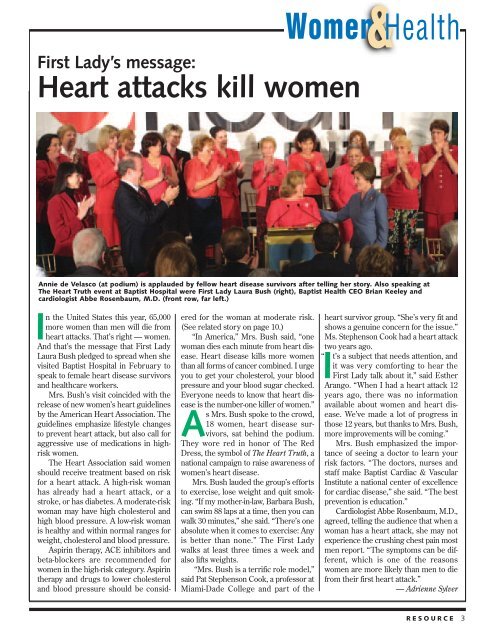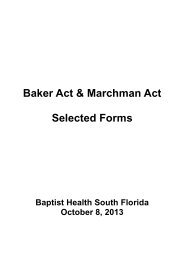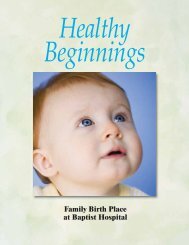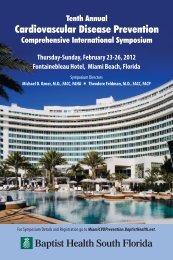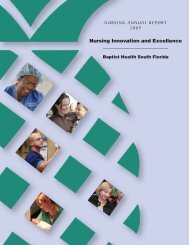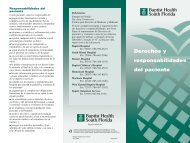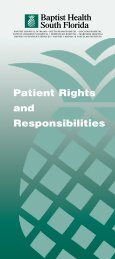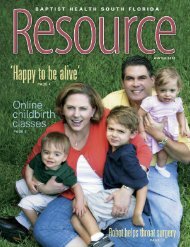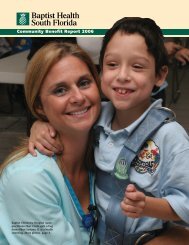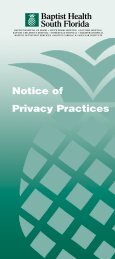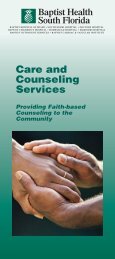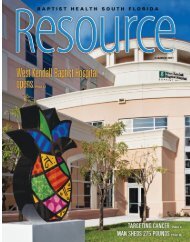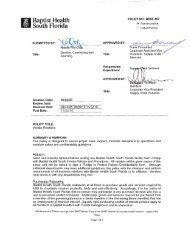Resource: Spring 2004 - Baptist Health South Florida
Resource: Spring 2004 - Baptist Health South Florida
Resource: Spring 2004 - Baptist Health South Florida
- TAGS
- baptist
- baptisthealth.net
You also want an ePaper? Increase the reach of your titles
YUMPU automatically turns print PDFs into web optimized ePapers that Google loves.
First Lady’s message:<br />
Heart attacks kill women<br />
In the United States this year, 65,000<br />
more women than men will die from<br />
heart attacks. That’s right — women.<br />
And that’s the message that First Lady<br />
Laura Bush pledged to spread when she<br />
visited <strong>Baptist</strong> Hospital in February to<br />
speak to female heart disease survivors<br />
and healthcare workers.<br />
Mrs. Bush’s visit coincided with the<br />
release of new women’s heart guidelines<br />
by the American Heart Association. The<br />
guidelines emphasize lifestyle changes<br />
to prevent heart attack, but also call for<br />
aggressive use of medications in highrisk<br />
women.<br />
The Heart Association said women<br />
should receive treatment based on risk<br />
for a heart attack. A high-risk woman<br />
has already had a heart attack, or a<br />
stroke, or has diabetes. A moderate-risk<br />
woman may have high cholesterol and<br />
high blood pressure. A low-risk woman<br />
is healthy and within normal ranges for<br />
weight, cholesterol and blood pressure.<br />
Aspirin therapy, ACE inhibitors and<br />
beta-blockers are recommended for<br />
women in the high-risk category. Aspirin<br />
therapy and drugs to lower cholesterol<br />
and blood pressure should be consid-<br />
ered for the woman at moderate risk.<br />
(See related story on page 10.)<br />
“In America,” Mrs. Bush said, “one<br />
woman dies each minute from heart disease.<br />
Heart disease kills more women<br />
than all forms of cancer combined. I urge<br />
you to get your cholesterol, your blood<br />
pressure and your blood sugar checked.<br />
Everyone needs to know that heart disease<br />
is the number-one killer of women.”<br />
As Mrs. Bush spoke to the crowd,<br />
18 women, heart disease survivors,<br />
sat behind the podium.<br />
They wore red in honor of The Red<br />
Dress, the symbol of The Heart Truth, a<br />
national campaign to raise awareness of<br />
women’s heart disease.<br />
Mrs. Bush lauded the group’s efforts<br />
to exercise, lose weight and quit smoking.<br />
“If my mother-in-law, Barbara Bush,<br />
can swim 88 laps at a time, then you can<br />
walk 30 minutes,” she said. “There’s one<br />
absolute when it comes to exercise: Any<br />
is better than none.” The First Lady<br />
walks at least three times a week and<br />
also lifts weights.<br />
“Mrs. Bush is a terrific role model,”<br />
said Pat Stephenson Cook, a professor at<br />
Miami-Dade College and part of the<br />
Women&<strong>Health</strong><br />
Annie de Velasco (at podium) is applauded by fellow heart disease survivors after telling her story. Also speaking at<br />
The Heart Truth event at <strong>Baptist</strong> Hospital were First Lady Laura Bush (right), <strong>Baptist</strong> <strong>Health</strong> CEO Brian Keeley and<br />
cardiologist Abbe Rosenbaum, M.D. (front row, far left.)<br />
heart survivor group. “She’s very fit and<br />
shows a genuine concern for the issue.”<br />
Ms. Stephenson Cook had a heart attack<br />
two years ago.<br />
“<br />
It’s a subject that needs attention, and<br />
it was very comforting to hear the<br />
First Lady talk about it,” said Esther<br />
Arango. “When I had a heart attack 12<br />
years ago, there was no information<br />
available about women and heart disease.<br />
We’ve made a lot of progress in<br />
those 12 years, but thanks to Mrs. Bush,<br />
more improvements will be coming.”<br />
Mrs. Bush emphasized the importance<br />
of seeing a doctor to learn your<br />
risk factors. “The doctors, nurses and<br />
staff make <strong>Baptist</strong> Cardiac & Vascular<br />
Institute a national center of excellence<br />
for cardiac disease,” she said. “The best<br />
prevention is education.”<br />
Cardiologist Abbe Rosenbaum, M.D.,<br />
agreed, telling the audience that when a<br />
woman has a heart attack, she may not<br />
experience the crushing chest pain most<br />
men report. “The symptoms can be different,<br />
which is one of the reasons<br />
women are more likely than men to die<br />
from their first heart attack.”<br />
— Adrienne Sylver<br />
RESOURCE 3


